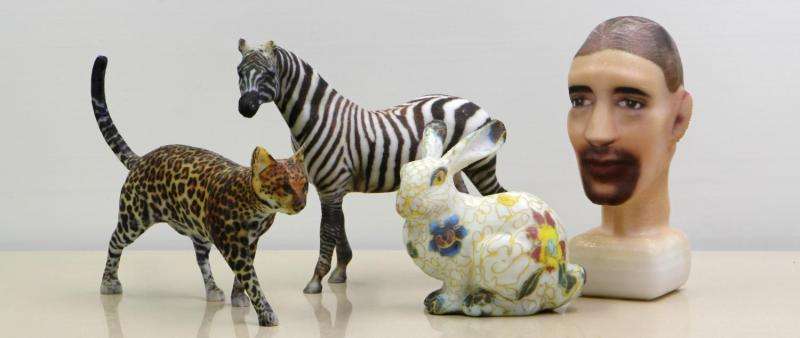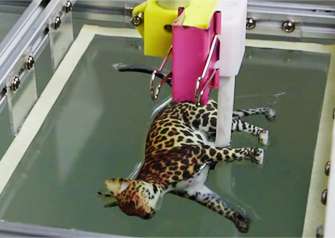New computational technique advances color 3-D printing process

Working with researchers at Zhejiang University in China, Changxi Zheng, assistant professor of computer science at Columbia Engineering, has developed a technique that enables hydrographic printing, a widely used industrial method for transferring color inks on a thin film to the surface of manufactured 3D objects, to color these surfaces with the most precise alignment ever attained. Using a new computational method they developed to simulate the printing process, Zheng and his team have designed a model that predicts color film distortion during hydrographic immersion, and uses it to generate a colored film that guarantees exact alignment of the surface textures to the object. The research will be presented at SIGGRAPH 2015, August 9 to 13, in Los Angeles.
"Attaining precise alignment of the color texture onto the surface of an object with a complex surface, whether it's a motorcycle helmet or a 3D-printed gadget, has been almost impossible in hydrographic printing until now," says Zheng. "By incorporating—for the first time—a computational model into the traditional hydrographic printing process, we've made it easy for anyone to physically decorate 3D surfaces with their own customized color textures."
Used in mass production for transferring repeated color patterns to a 3D surface, hydrographic printing can be applied to various materials including metal, plastic, wood, and porcelain. The process uses a PVA film with printed color patterns placed on top of water. An activator chemical is then sprayed on the film, softening the color film to make it easily stretchable. Next, a physical object is slowly dipped into the water through the floating film. Once the film touches the object, it gets stretched, wrapping the object's surface, and adhering to it. Throughout the process, the color ink printed on the PVA film is transferred to the surface. But the process has a fundamental limitation in that it is almost impossible to precisely align a color pattern to the object surface, because the object stretches the color film. With complex surfaces, the stretch can be severe and even tear the film apart.
"So current hydrographic printing has been limited to transferring repetitive color patterns," Zheng explains. "But there are many times when a user would like to color the surface of an object with particular color patterns, to decorate a 3D-printed mug with specific, personalized images or just to color a toy."
Building upon previous work on fluid and viscous sheet simulation also done at Columbia Computer Graphics Group, Zheng has developed a new viscous sheet simulation method to model the color film stretch during the hydrographic printing process. This model predicts the stretch and distortion of color films and creates a map between the locations on the film and the surface locations to which they are transferred. With the map, he can compute a color image for printing on the PVA film and then, after the hydrographic immersion, it forms the desired color pattern on the object's surface.

To prove that this simulation works, Zheng and his collaborators in China used off-the-shelf hardware to build a calibrated system in which a mechanical apparatus precisely controls the object immersion, and a 3D-system measures the object orientation and its dipping location. With the incorporation of Zheng's simulation model, they were able to compute a color image to feed into their hydrographic system for precise texture registration. To avoid severe film distortion and the danger of the film tearing, they introduced a multi-immersion design: the object can be dipped multiple times, each with a different orientation and a film printed with a different color pattern. The computation of color patterns allows the transferred colors from individual immersions to be combined into the desired "final" surface decoration.
"This system is easy to set up for personal use and it's quite inexpensive, less than 40 U.S. cents per printing," Zheng notes. "And it works for a wide range of complex surface geometries and materials."
He adds, "This was a challenging but fun project. I'm very interested in the interaction between the virtual world and the real world, and this research is a good example of how virtual-world computation can work hand-in-hand with a real-world manufacturing process and significantly improve the production quality."
More information: www.cs.columbia.edu/cg/hydrographics/




















